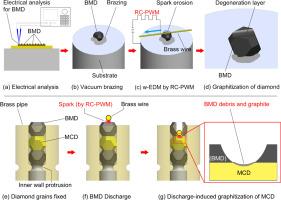放电诱导单晶金刚石石墨化:一种用于BMD和非导电MCD的火花侵蚀方法
IF 5.1
3区 材料科学
Q2 MATERIALS SCIENCE, COATINGS & FILMS
引用次数: 0
摘要
单晶金刚石(MCD)是一种超硬材料,由于其优异的机械、物理和化学性能,被广泛应用于各种工业领域,被认为是下一代技术的关键材料。为了使MCD加工具有成本效益,提出了一种利用电火花加工(EDM)的放电诱导石墨化方法。设计了一种电阻-电容脉宽调制(RC-PWM)放电电源来支持这一过程。通过调整放电脉冲串的占空比,RC-PWM电源提供所需的工作能量,使MCD能够在其击穿电压下加工,同时最大限度地减少过度的热损伤。引入瞬时电压检测方法,自动调节线电极馈电速率,有效防止短路和电极断裂。通过RC-PWM放电电源产生的火花侵蚀率(SER)来评价MCD的放电加工性(EDP)。在掺硼单晶金刚石(BMD)的加工过程中,石墨沉积层和放电碎屑的形成使得对不导电的MCD进行连续电火花加工成为可能。实验结果表明,在300 kHz的放电频率下,最佳脉冲导通比分别为30%和40%,可以加工BMD和非导电MCD。在BMD中确定了四种材料去除机制:侵蚀、蒸发、蒸发与侵蚀和烧蚀。相反,由于缺乏导电载流子,在非导电MCD中只发生汽化和烧蚀。这项研究为非导电金刚石材料的电火花加工提供了一种具有成本效益和技术前景的方法,具有技术自主和未来商业化的潜力。本文章由计算机程序翻译,如有差异,请以英文原文为准。

Discharge-induced graphitization of monocrystalline diamond: A spark erosion approach for BMD and non-conductive MCD
Monocrystalline diamond (MCD), a superhard material widely used in various industrial applications due to its exceptional mechanical, physical, and chemical properties, is considered a key material for next-generation technologies. To enable cost-effective machining of MCD, a discharge-induced graphitization method using electrical discharge machining (EDM) is proposed. A resistance-capacitance pulse-width modulation (RC-PWM) discharge power source is designed to support this process. By adjusting the duty ratio of the discharge pulse train, the RC-PWM power source delivers the required working energy, allowing MCD to be machined at its breakdown voltage while minimizing excessive thermal damage. An instantaneous voltage detection method is introduced to autonomously regulate the wire-electrode feed-rate, effectively preventing short-circuits and electrode breakage. The electrical discharge processability (EDP) of MCD is evaluated through the spark erosion rate (SER) achieved with the RC-PWM discharge power source. During the machining of boron-doped monocrystalline diamond (BMD), the formation of a graphite deposition layer and discharge debris enables continuous EDM of otherwise non-conductive MCD. Experimental results show that BMD and non-conductive MCD can be machined at a discharge frequency of 300 kHz, with optimal pulse-on-time ratios of 30 % and 40 %, respectively. Four material removal mechanisms: erosion, vaporization, vaporization with erosion, and ablation are identified in BMD. In contrast, only vaporization and ablation occur in non-conductive MCD due to the absence of conductive charge carriers. This study presents a cost-effective and technically promising approach for the EDM processing of non-conductive diamond materials, with potential for technological autonomy and future commercialization.
求助全文
通过发布文献求助,成功后即可免费获取论文全文。
去求助
来源期刊

Diamond and Related Materials
工程技术-材料科学:综合
CiteScore
6.00
自引率
14.60%
发文量
702
审稿时长
2.1 months
期刊介绍:
DRM is a leading international journal that publishes new fundamental and applied research on all forms of diamond, the integration of diamond with other advanced materials and development of technologies exploiting diamond. The synthesis, characterization and processing of single crystal diamond, polycrystalline films, nanodiamond powders and heterostructures with other advanced materials are encouraged topics for technical and review articles. In addition to diamond, the journal publishes manuscripts on the synthesis, characterization and application of other related materials including diamond-like carbons, carbon nanotubes, graphene, and boron and carbon nitrides. Articles are sought on the chemical functionalization of diamond and related materials as well as their use in electrochemistry, energy storage and conversion, chemical and biological sensing, imaging, thermal management, photonic and quantum applications, electron emission and electronic devices.
The International Conference on Diamond and Carbon Materials has evolved into the largest and most well attended forum in the field of diamond, providing a forum to showcase the latest results in the science and technology of diamond and other carbon materials such as carbon nanotubes, graphene, and diamond-like carbon. Run annually in association with Diamond and Related Materials the conference provides junior and established researchers the opportunity to exchange the latest results ranging from fundamental physical and chemical concepts to applied research focusing on the next generation carbon-based devices.
 求助内容:
求助内容: 应助结果提醒方式:
应助结果提醒方式:


